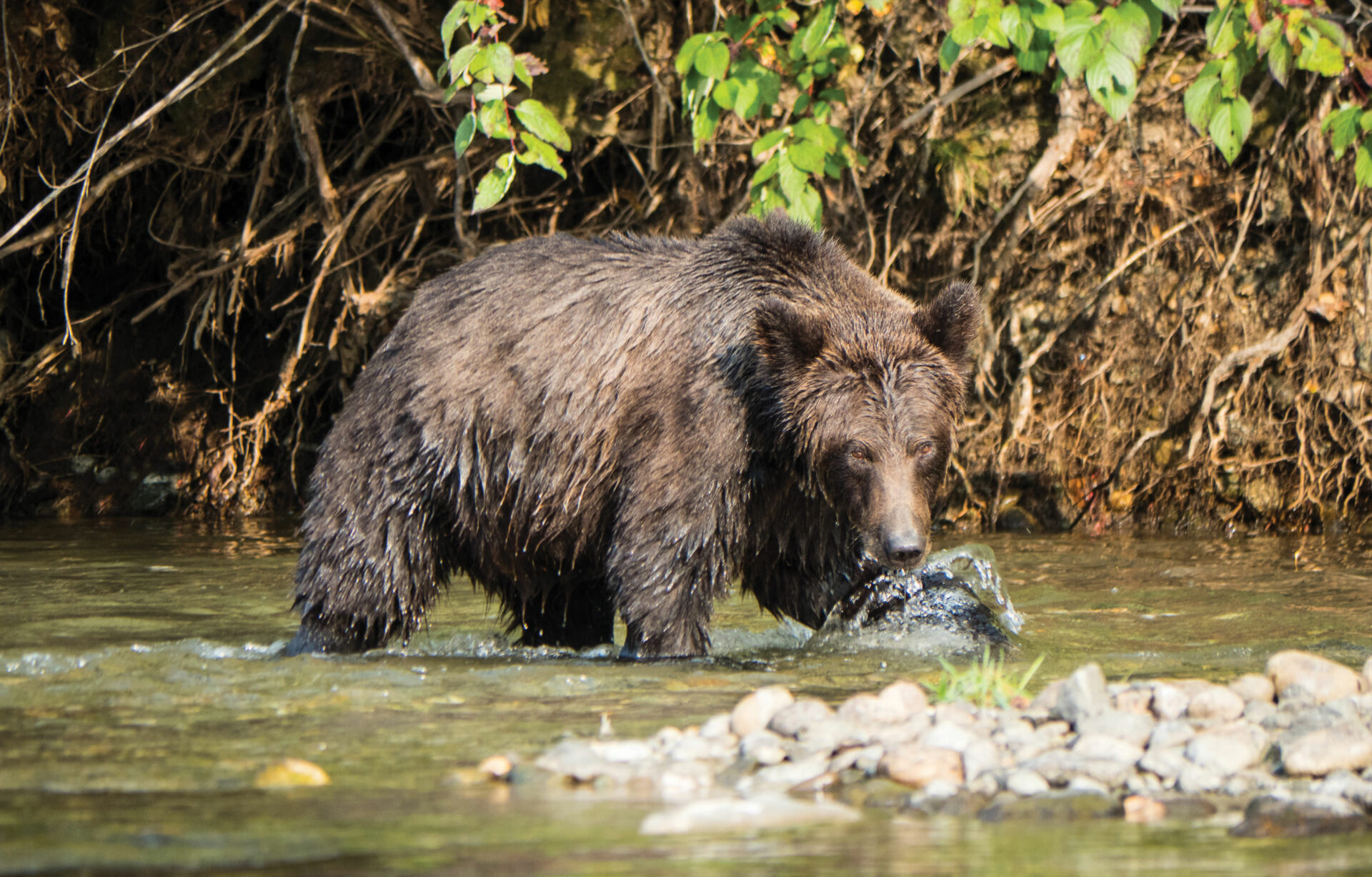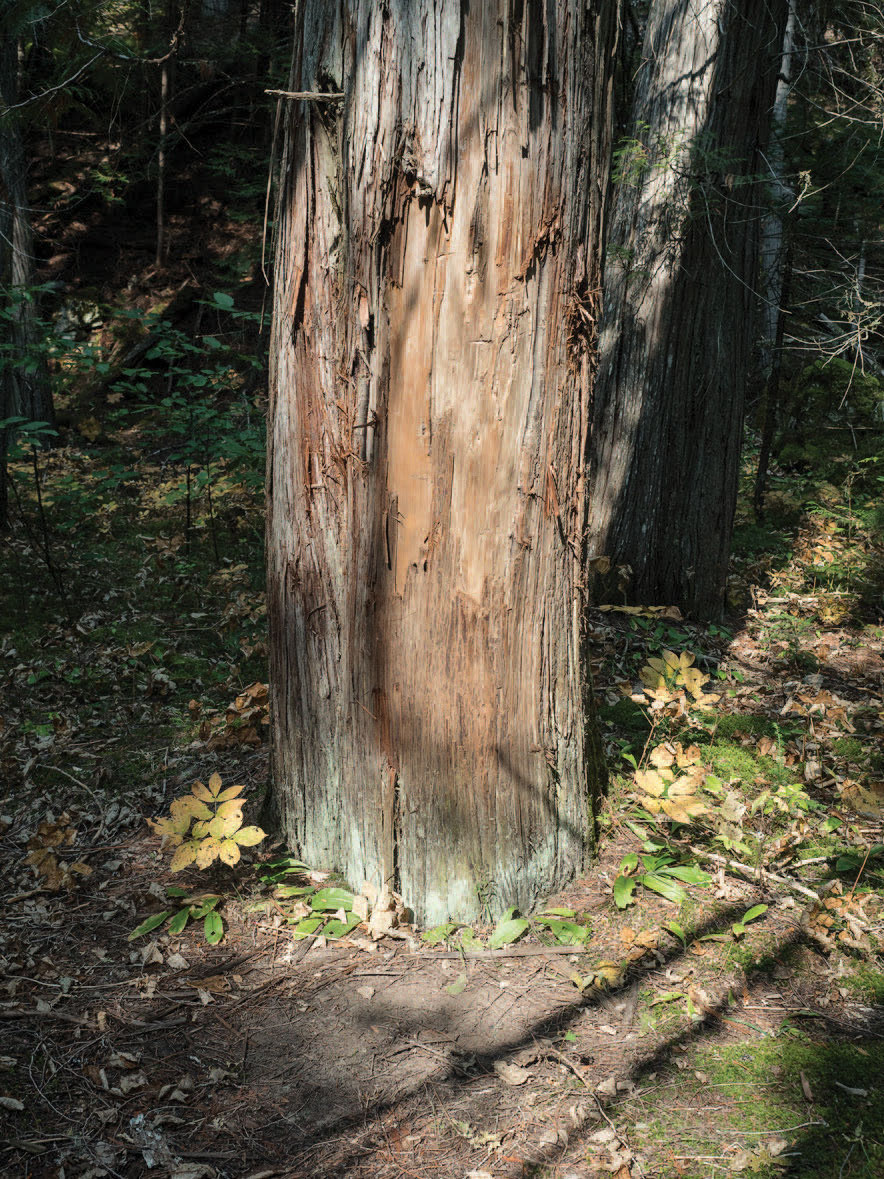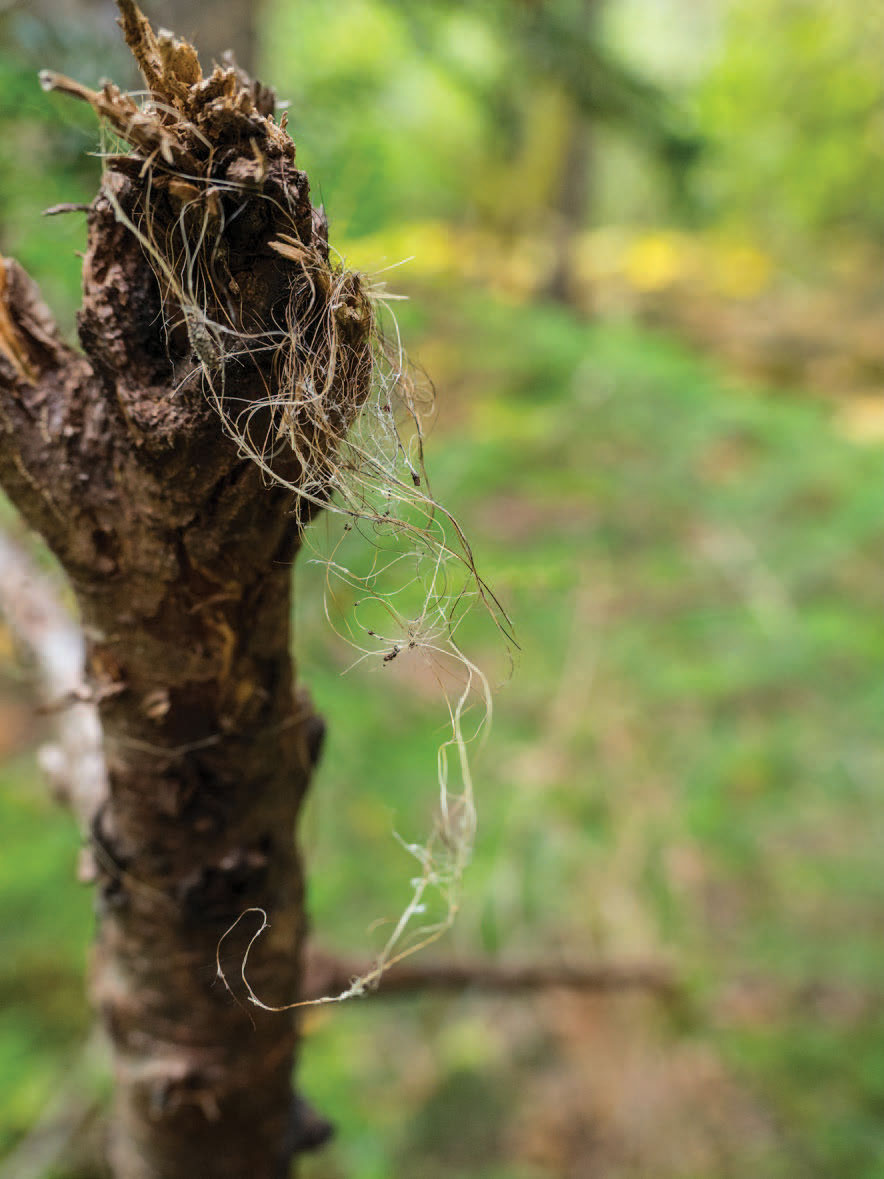Submerged up to their chins in the Atnarko River, two second-year grizzly cubs seem relaxed as they scoop pink salmon out of the cold clear water. Our guide, Jessib Padgett from Tweedsmuir Park Lodge, steers our drift boat to the far side of the river and drops the anchor over the side. Moments later a third cub, followed closely by mama, pops out of the dense brush bordering the river. Soon, all four bears are preparing for winter by gorging themselves at the prime feeding spot, seemingly unbothered by the small boatload of tourists who have come to see them.
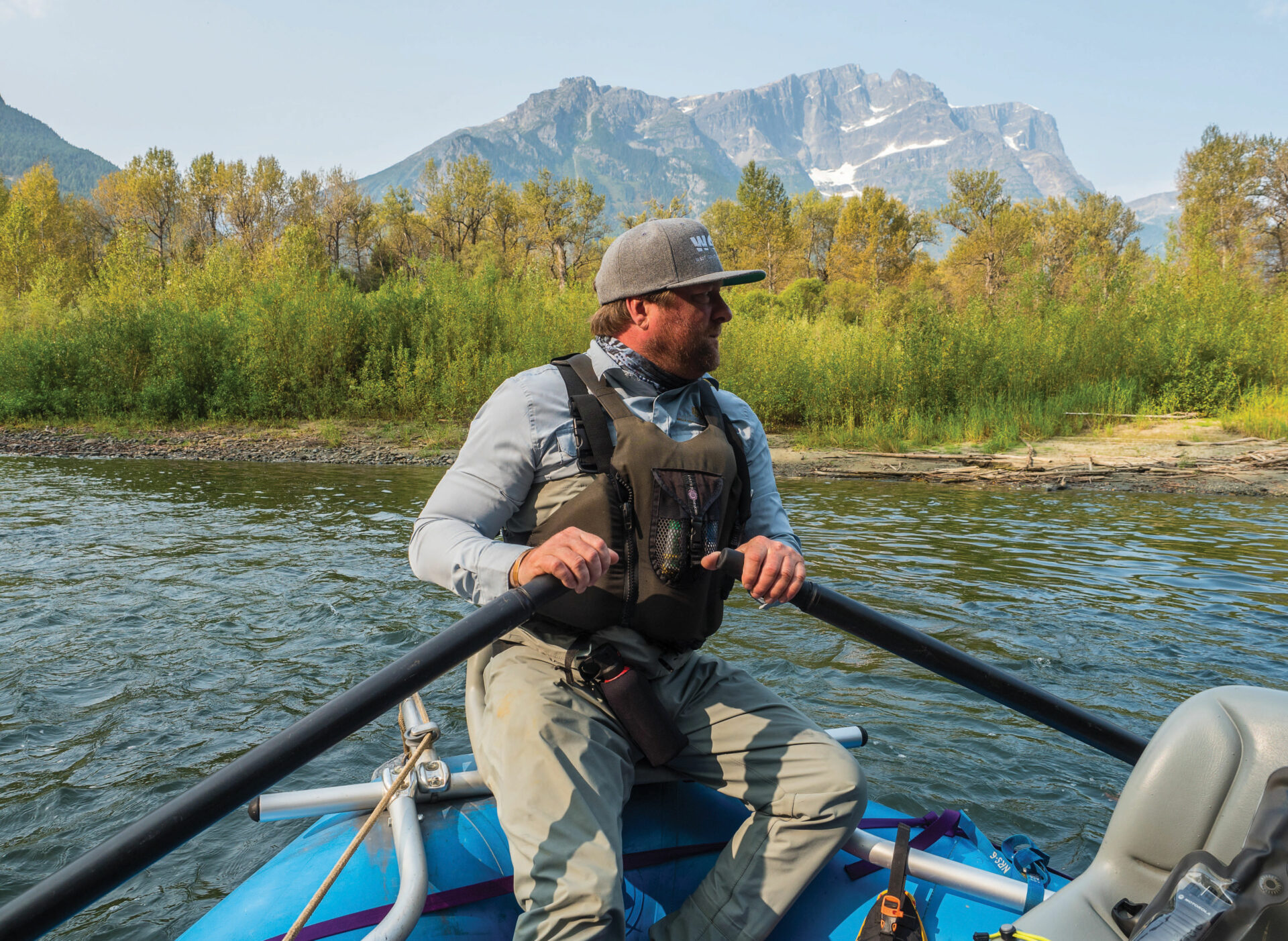
As we watch, the bears continue their relaxed journey upstream, climbing up over log jams, swimming across swirling patches of current and casually noshing on the fatty flesh of salmon. Just around the next bend they’ll reach the Belarko Wildlife Viewing Platform, one of Tweedsmuir Provincial Park’s land-based viewing stations, where BC park rangers interpret bear behaviour for park guests.
Adjacent to Belarko is a scientific “hide,” one of several on the river. Perched up on a camouflaged tower, on what look like chairlift seats, the researchers are recording foraging rates (how much salmon is caught in a time period), capture efficiency (how many attempts it takes to catch a salmon) and key behaviours like vigilance.
Even as the bears go about their predictable-seeming life on the Atnarko, this multi-year study by BC Parks, the Nuxalk Nation Stewardship Department and the University of Victoria seeks to understand how the presence of ecotourism is affecting grizzlies. The question is whether grizzly behaviour changes when humans are present, and if it does, what this means to the well-being of the bears, as well as to the local human population.
It’s one of a handful of studies occurring in BC, all of which are trying to unravel the needs of the province’s estimated 15,000 grizzly bears. As a species of special concern, their future is far from certain. And as bear viewing increases in popularity and human activity continues to push into traditional grizzly habitat, there is a growing realization that we simply don’t know enough about Ursus arctos horribilis to ensure their preservation.
Pulling up the anchor, Jessib uses the boat’s big oars to sweep us back into the gentle current and we continue to float downstream. Bald eagles fly above us while the rugged peaks of Stupendous Mountain and Melikan Mountain frame the river.
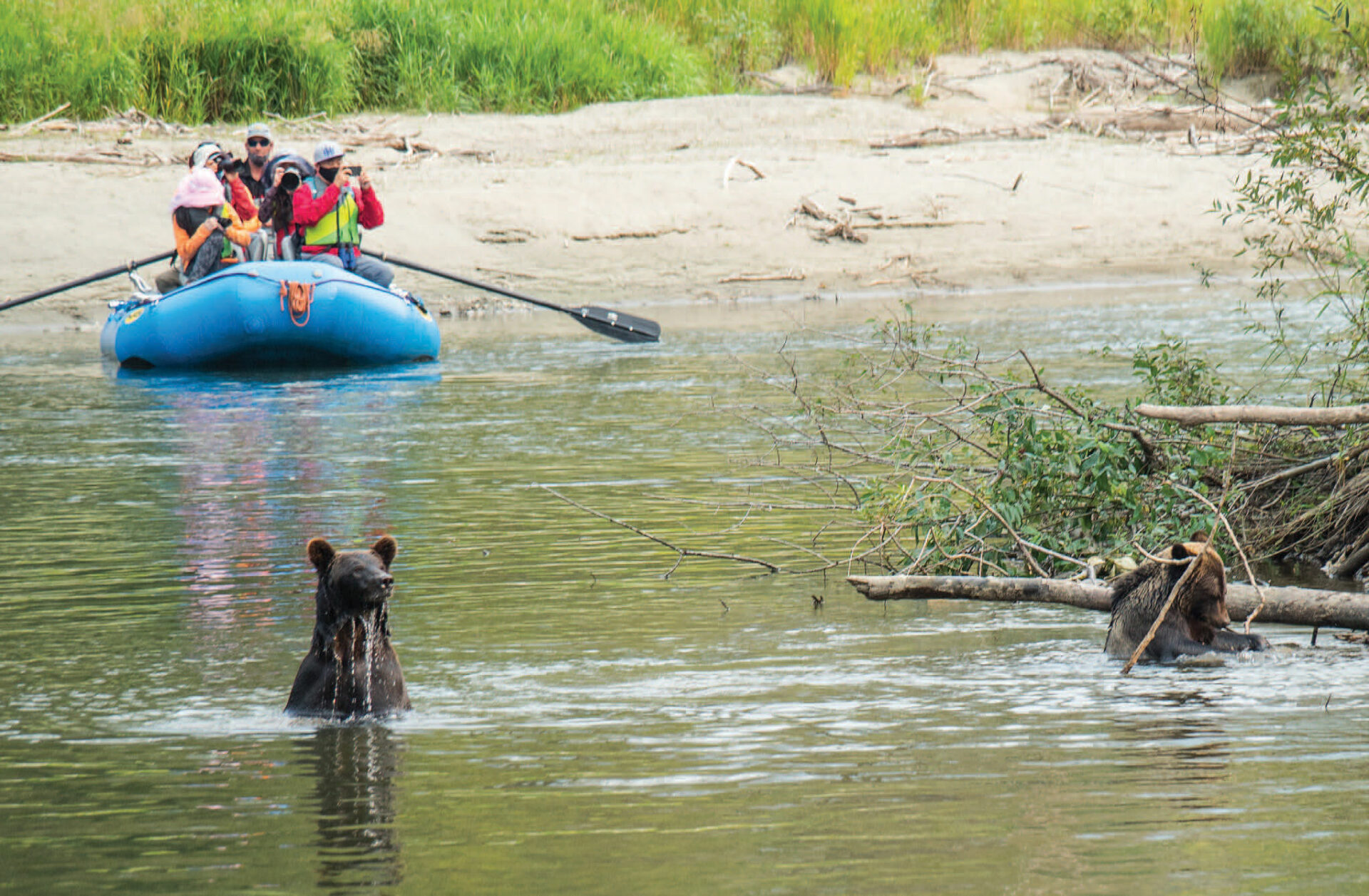
Around the next bend we catch sight of a solitary bear. Jessib says this is a young subadult, newly out on its own. He explains one of the unique things about this stretch of river is the number of smaller bears that feed on it. In fact, our being here might actually be what’s protecting the young bear. Anecdotally, it appears smaller subadults and females with cubs choose to feed in this busy viewing corridor because the dominant male bears don’t.
It’s an intriguing symbiotic human/bear behaviour that’s been described by bear guides and hinted at in studies. The theory is that because dominant male bears tend to avoid humans, the more vulnerable bears seek out areas where tourists gather. The result is the cubs are safer (males have been known to kill cubs to bring the female bears into estrus) and smaller bears have unfettered access to better feeding grounds. It’s one of the theories the UVic/Nuxalk/BC Parks study is hoping to confirm or disprove.
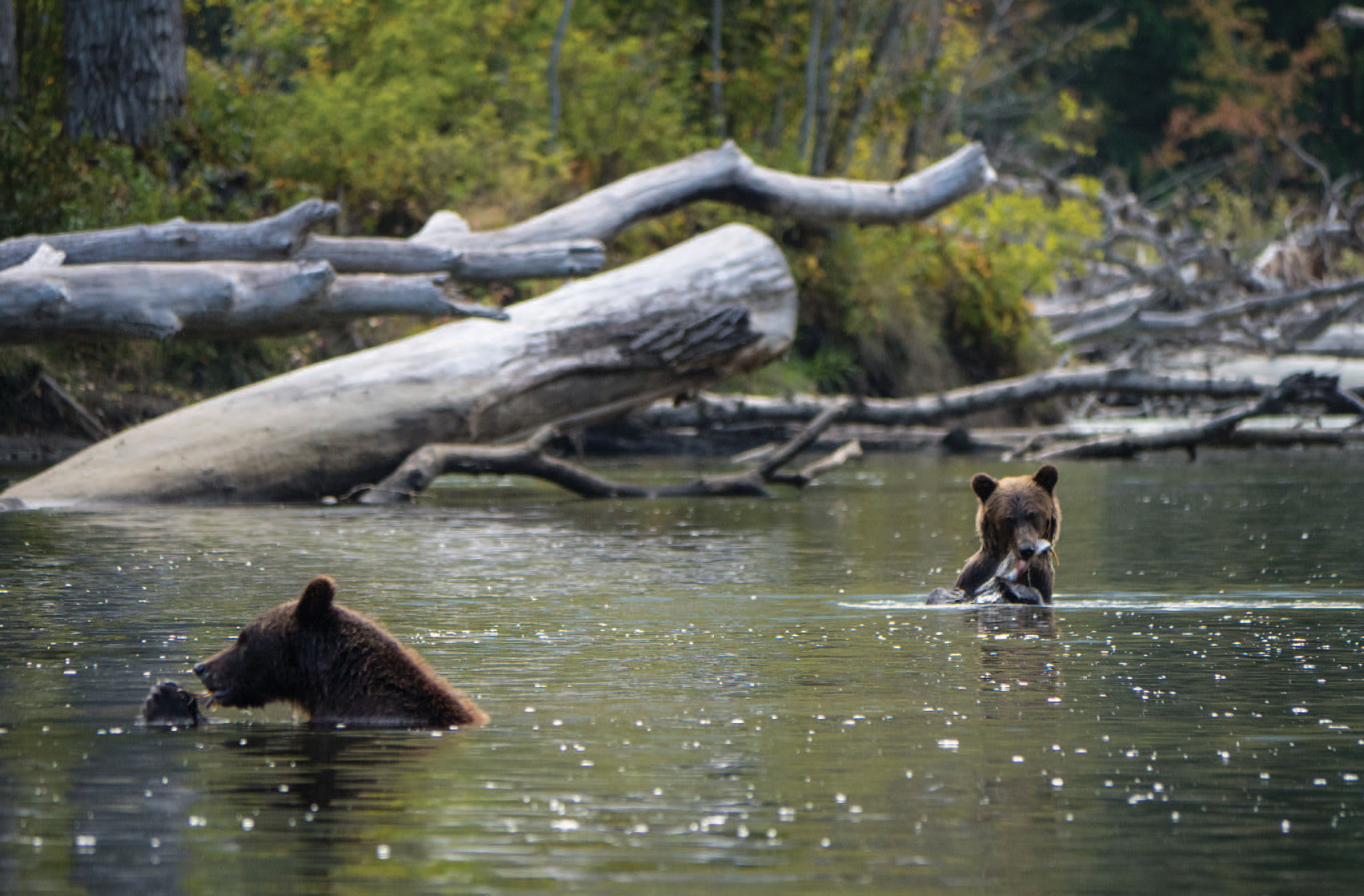
The young bear makes a comedic lunge after a salmon and comes up empty, shaking its shaggy head like a dog. The river banks and shallows are scattered with the carcasses of spawned out fish, and the breeze carries the tang of rot. Diving into a deeper pool, the bear has success, surfacing with a still flapping fish in its jaws. After it’s eaten its snack, we watch until it’s climbed up the river bank and disappeared into the bush.
Back underway, Jessib steers the boat to our take-out point at a provincial park campground, near where the Atnarko runs into the much siltier Bella Coola River. Jessib tells us the bears can’t spot salmon in the murky depths of the larger Bella Coola—which is part of what makes the 100-kilometre long Atnarko so special. And as we return to Tweedsmuir Park Lodge I have a new appreciation for the foresight of the lodge’s founders.
First built in 1931, Tweedsmuir Park Lodge (called Stuie Lodge at the time) predates the eponymous park by seven years. Set on a bucolic, U-shaped piece of property that borders a sweeping curve of the Atnarko River, the historic lodge was originally marketed to international game hunters who paid $40 a week to “hunt grizzly during the day and return to a hot bath and comfortable bed in the evening.”
These days, the lodge attracts an international group of visitors who are equally appreciative of the lodge’s rustically luxurious comforts. It also employs world-renowned bear guides who have a markedly different skill set than their earlier counterparts. Part of the Commercial Bear Viewing Association of BC (CBVA) since 2010, Tweedsmuir Park Lodge has joined forces with a group of ecotourism businesses to promote sustainable bear viewing in BC.
The role of the CBVA is twofold. It offers guide training, which teaches “best practices” in regard to bear viewing, including education on current research and skills on how to minimize risk for both bears and humans. The CBVA also advocates for the protection of grizzlies and their habitat. The organization played a strong role in stopping trophy hunting in 2018, arguing (and eventually proving) that grizzly bears are worth far more to the province alive in the forest than as a hunter’s prize.
The hazy early morning sun was just hitting the mountain peaks when I walked down to the lodge’s hide and joined a few of the other guests who were already on the lookout for bears. In a typical year, the rugged beauty of Tweedsmuir Provincial Park in fall mostly attracts international visitors who want to experience the quintessential Canadian wilderness. But for this strange Covid year we’re a mash-up of British Columbians who happened upon the lodge when trying to find something special to replace trips to places like South Africa, Switzerland or Indonesia.
Our quiet good-mornings stopped abruptly as a mature lone female wandered into view. Tracking her movements with camera lenses, our comments of awe were tinged with concern as we exchanged conservation facts gleaned from our guides. Last year had been a catastrophic year for salmon—and a lone female was a sign that the cubs hadn’t survived. Unlike international visitors, we realized our choices as Canadians have a direct impact on the ongoing survival of the bears and the continued wildness of this region.
Our guides for the day met us at the hide, and watched with us as the bear rounded the curve and headed out of sight. As self-proclaimed “bear geeks,” many of the guides spend hours of their own time exploring the woods of Tweedsmuir, following bear trails and looking for rub trees, stomp trails and scat.
Today, I’d asked to explore the forest, to see if we could retrace one guide’s path to a stomp trail and rub tree. Tree rubbing is a unique social behaviour that was determined in a 2021 study to be a method of communication (and not a way to scratch an itch). Originally conceived as a way to gain insight into the habitat and population density of grizzly bears, the study went on to suggest that when bears stomp into the exact same spots as they approach rub trees, they leave behind scent markers which somehow determine how female grizzly bears pick their mates.
This stomping also leaves behind visible footprints—something I wanted to see.
As we meandered through the underbrush, along game trails and over creek beds, our guide pointed out the numerous indications of the hidden lives of bears. There were the berries bears eat, the cosy spots where they built napping nests and trees where they’d rubbed the bark smooth. We also encountered culturally modified trees, abundant patches of kinnikinnick and edible mushrooms—all signs of the rich Nuxalk habitation in the area.
Eventually we followed a game trail to a section of the forest where soft light filtered through the dense trees and deep green moss covered the ground. Leading off one section of the game trail was a mysterious pathway of deeply worn footprints.
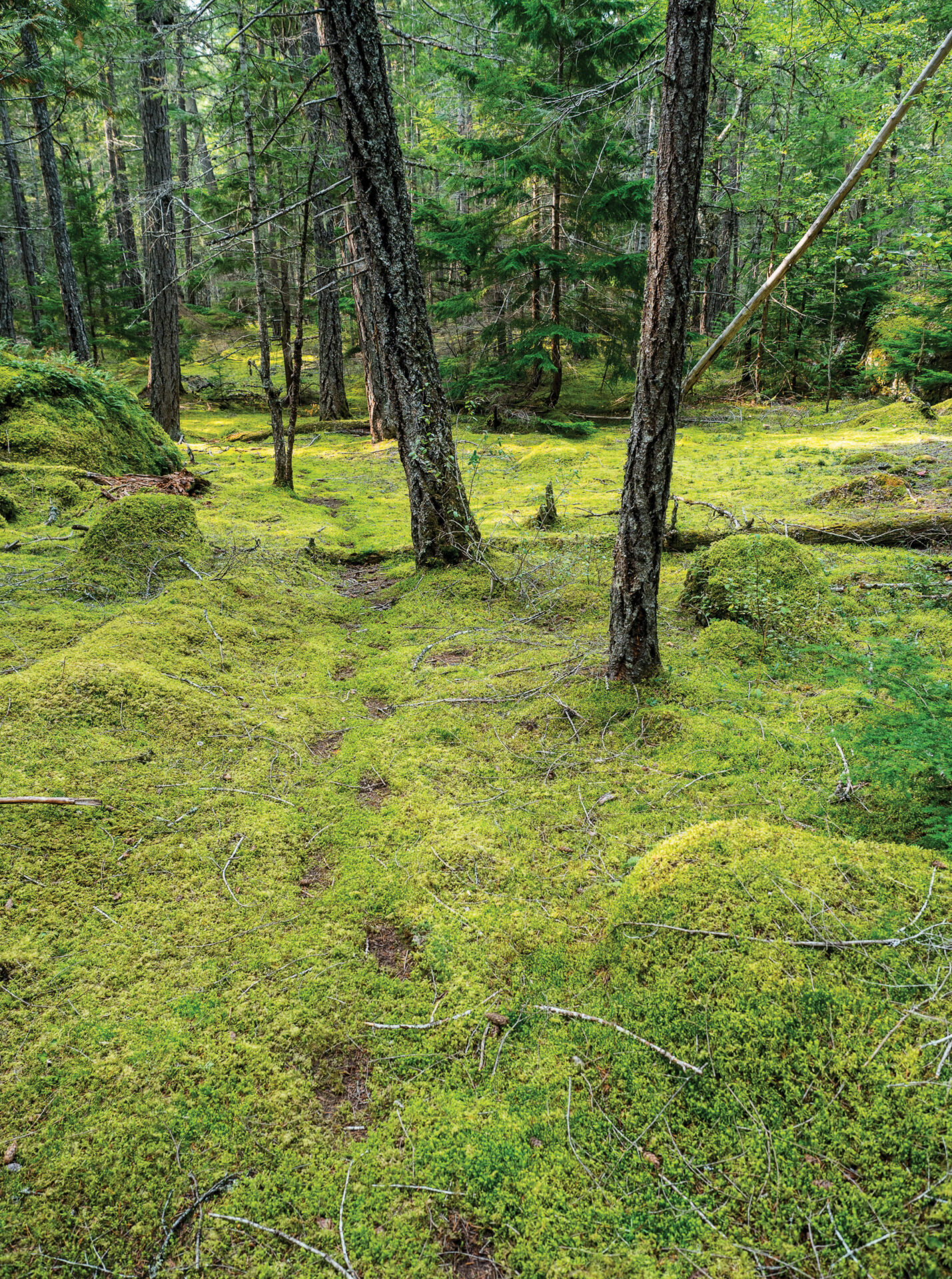
I’m not sure what I expected of the stomp trail, but what I felt was reverence. Here was a message, written deep in the woods, from one generation of bears to the next. For our part, we can barely even guess what it means.
Even as we’ve altered habitat, changed the climate, put food resources at risk and hunted them, grizzlies have continued to adapt. There are signs that some populations of bears are becoming smaller in stature as the salmon runs shrink and they turn to berries. As land corridors close or shift, the bears have disappeared from some areas and reappeared in others. Young male grizzlies have taken up residence on Vancouver Island for the first time in known history.
On the Atnarko, it’s romantic to imagine that the fall-feeding frenzy of bears and fish continues ancient and unchanging. But despite Tweedsmuir Park’s healthy grizzly population of an estimated 368 bears, there are clues telling us that all is not well. Some years there are a dozen new and yearling cubs on this stretch of the Atnarko, so far this season there are none. Bears popular in other years haven’t returned—and new ones haven’t taken their places.
This season though, the salmon is abundant.
On my final morning I slip down to the hide, hoping to see one last bear before it’s time to leave. Moments after I arrive, a shy subadult I hadn’t seen before came around the bend. Cautiously skirting the hide, I watch as it tests the air for our scent, forgoing fishing as it seems to try and decide if we’re a threat. Somewhere, hidden in the trees nearby, I imagine researchers monitoring this behaviour, trying to answer this very same question.
Grizzlies by the Numbers:
Before settlers came, the western grizzly populations ranged from northern Mexico all the way up the continent to the Arctic and from the Pacific east to Manitoba. Because grizzly bears require vast areas of land, with unimpeded corridors of wilderness to connect them, habitat fragmentation and human development have put them at risk. Then there’s the fact that for almost a century grizzlies were shot on sight.
By 1972 they were endangered, an estimate put their number at 6,000 to 7,000 animals in BC. This estimate rose to 13,000 in 1990, and 17,000 in 2004, before dropping to 15,000 in 2012. Improvements in how grizzly numbers are estimated put their number at 14,925 in 2018.
During this same period grizzly deaths were better tracked. According to provincial data compiled by the David Suzuki Foundation, between 1975 and 2016 an estimated 13,804 grizzly bears were killed by humans. Eighty-seven percent of the animals were legally hunted—the remaining number were poached or killed in bear/human conflicts.
If You Go
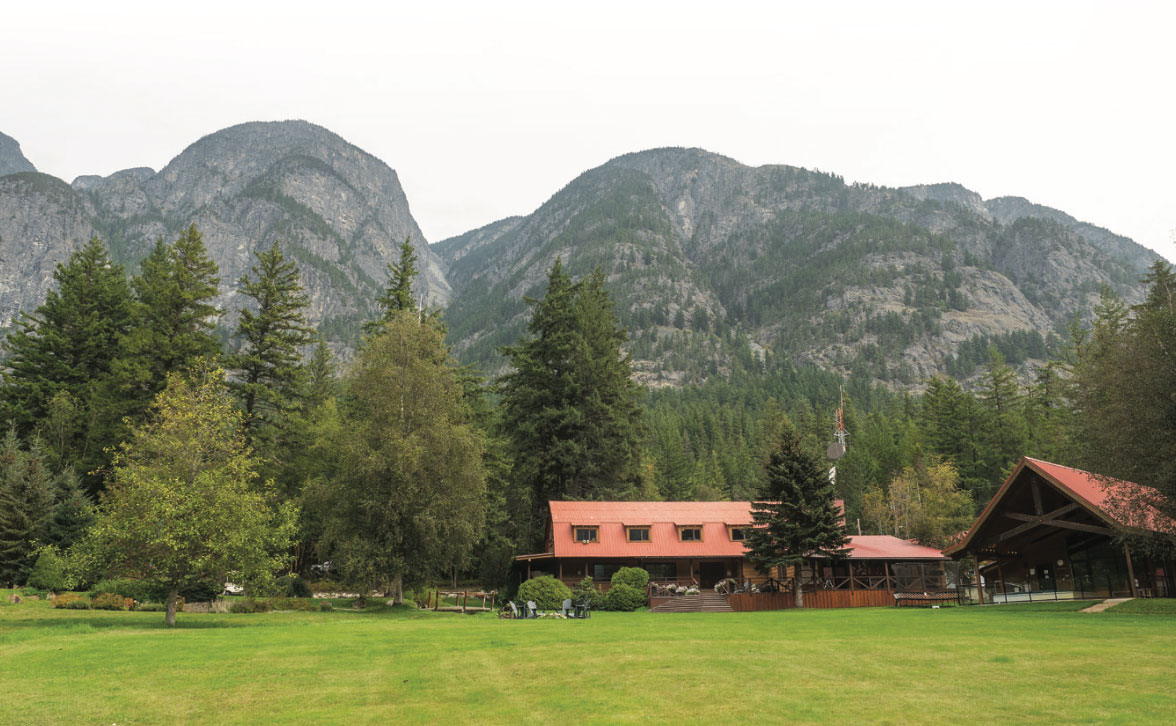
In late summer/early fall, when the salmon arrive to spawn (roughly September 1 to October 15), Bella Coola and Tweedsmuir Park are host to huge concentrations of grizzlies. Tweedsmuir Park Lodge’s “Grizzly Safaris” run for three to five days and include airport transfers, accommodation, meals, guided walks and river drifts.
604-905-4994
COVID-19 Protocols
Most businesses are open at time of press, but are operating under COVID-19 regulations, including reduced services and reduced capacities. Check before you visit.
